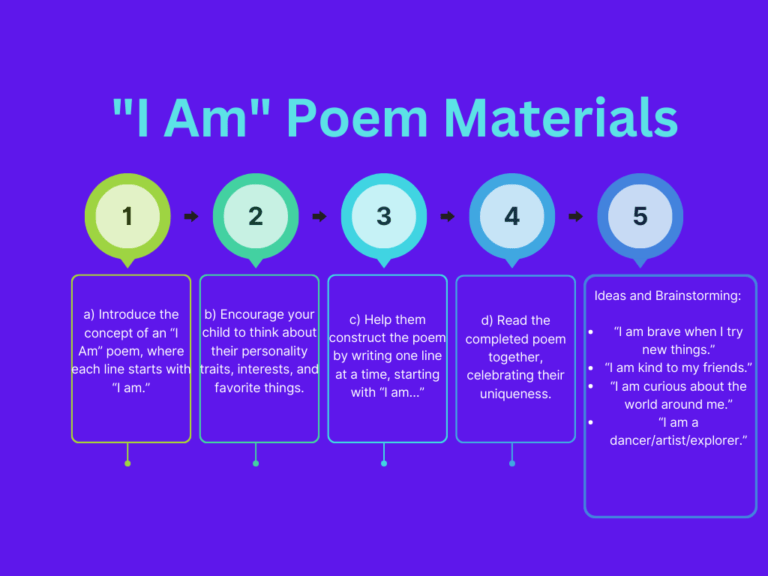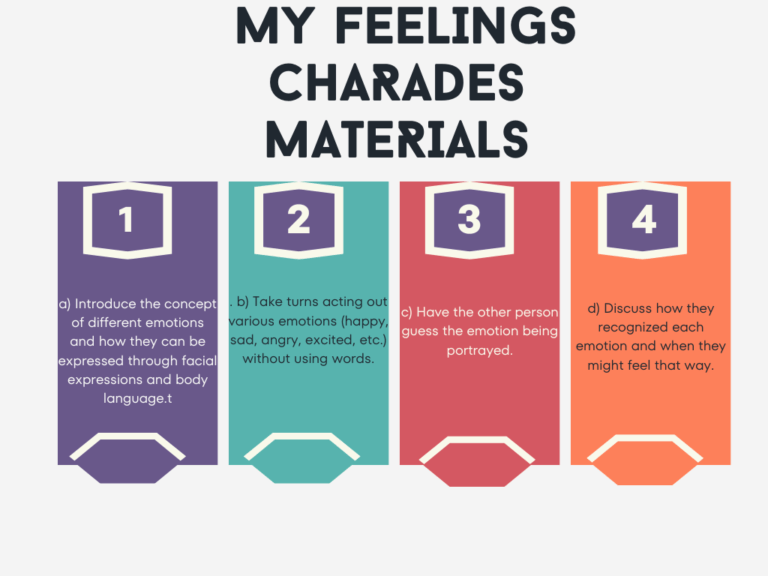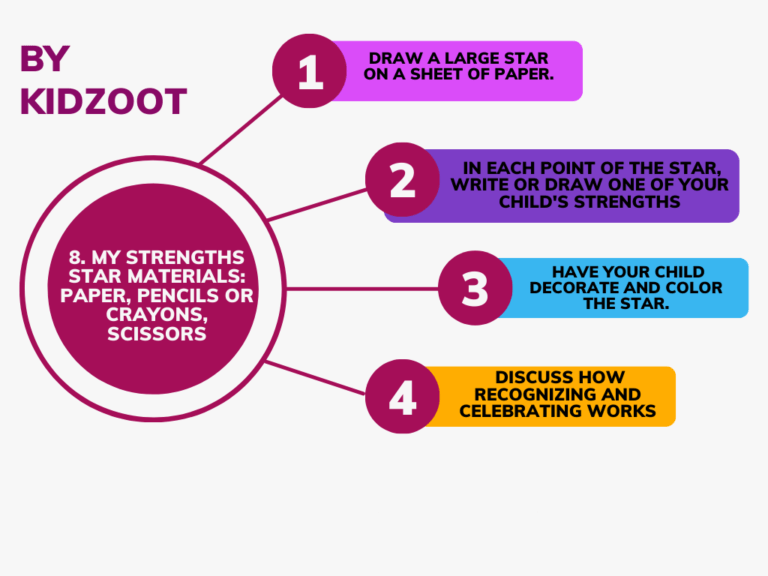The preschool years are a crucial time for children to develop a positive self-concept – their perception and understanding of themselves. A strong, healthy self-concept provides the foundation for confidence, self-esteem, and emotional well-being throughout life. As parents and caregivers, we can nurture this development through engaging and age-appropriate activities.
In this blog post, we’ll explore 10 creative self-concept activities designed to help preschoolers learn about themselves, recognize their strengths and uniqueness, and feel empowered. Let’s dive in!
1. Me Collage Materials: Magazines, catalogs, construction paper, glue, scissors
Steps: a) Gather various magazines and catalogs with colorful images. b) Provide your child with a large sheet of construction paper. c) Encourage them to cut out pictures, words, or shapes that represent their interests, favorite things, or aspects of their personality. d) Glue the cutouts onto the paper to create a collage that represents their unique self.
Ideas and Brainstorming:
- Look for images of their favorite animals, toys, foods, or activities.
- Cut out words or letters that spell their name or describe their qualities (kind, brave, funny).
- Discuss why they chose each item and what it means to them.

2. "I Am" Poem Materials: Paper, pencils or crayons
Steps: a) Introduce the concept of an “I Am” poem, where each line starts with “I am.” b) Encourage your child to think about their personality traits, interests, and favorite things. c) Help them construct the poem by writing one line at a time, starting with “I am…” d) Read the completed poem together, celebrating their uniqueness.
Ideas and Brainstorming:
- “I am brave when I try new things.”
- “I am kind to my friends.”
- “I am curious about the world around me.”
- “I am a dancer/artist/explorer.”
3. My Handprint Keepsake Materials: Paper, paint (various colors), markers or crayons
Steps: a) Have your child paint their handprint on a sheet of paper. b) Once the paint dries, use markers or crayons to decorate the handprint with their name, age, and any other details they want to include. c) Encourage them to express their creativity by adding patterns, shapes, or drawings around the handprint. d) Display the keepsake as a reminder of their special qualities at this age.
Ideas and Brainstorming:
- Use different colors to represent their favorite things (blue for the sky, green for trees).
- Draw self-portraits, family members, or pets around the handprint.
- Write positive affirmations or words that describe them.

4. My Feelings Charades Materials: None (or optional props like emotions cards or faces)
Steps: a) Introduce the concept of different emotions and how they can be expressed through facial expressions and body language. b) Take turns acting out various emotions (happy, sad, angry, excited, etc.) without using words. c) Have the other person guess the emotion being portrayed. d) Discuss how they recognized each emotion and when they might feel that way.
Ideas and Brainstorming:
- Use emotion cards or pictures to help children identify and name different feelings.
- Encourage them to share times when they felt a particular emotion and why.
- Talk about appropriate ways to express and cope with strong emotions.
5. My Unique Qualities Book Materials: Paper, pencils or crayons, stapler or binder
Steps: a) Create a simple book by folding and stapling several sheets of paper together. b) On each page, write or draw something unique about your child (e.g., “I have curly hair,” “I love to dance,” “I am a good friend”). c) Encourage your child to illustrate each page with drawings or cut-out images. d) Read the book together, celebrating their special qualities.
Ideas and Brainstorming:
- Include physical traits, talents, interests, and positive personality traits.
- Ask your child what they think makes them special or different from others.
- Discuss how their unique qualities contribute to their individuality.
6. My Family Tree Materials: Paper, pencils or crayons, family photos (optional)
Steps: a) Draw a simple tree trunk and branches on a sheet of paper. b) Explain that the tree represents their family, with the trunk being the parents and the branches being the children or other family members. c) Help your child add their name and those of their family members to the tree. d) Discuss how each person is unique and important to the family.
Ideas and Brainstorming:
- Use photos or drawings to represent each family member on the tree.
- Talk about special traditions, cultural backgrounds, or family values.
- Emphasize how their family is unique and special in its own way.
7. My Favorite Things Scavenger Hunt Materials: List of items or clues, camera or drawing materials (optional)
Steps: a) Create a list of your child’s favorite things (toys, foods, colors, animals, etc.) or write clues about them. b) Hide or place these items around the house or outdoor area. c) Give your child the list and have them search for and identify each item. d) Optionally, have them take photos or draw pictures of the found items.
Ideas and Brainstorming:
- Encourage your child to explain why each item is a favorite and what they like about it.
- Discuss how their preferences and interests contribute to their unique personality.
- Adapt the difficulty level by providing more or fewer clues or hints.

8. My Strengths Star Materials: Paper, pencils or crayons, scissors
Steps: a) Draw a large star on a sheet of paper. b) In each point of the star, write or draw one of your child’s strengths or accomplishments (e.g., “I can tie my shoes,” “I am a good reader,” “I am helpful”). c) Have your child decorate and color the star. d) Discuss how recognizing and celebrating their strengths can boost their confidence.
Ideas and Brainstorming:
- Encourage your child to identify their own strengths and accomplishments.
- Talk about how they developed these strengths and the effort they put in.
- Remind them that everyone has different strengths, and it’s essential to appreciate and nurture them.
9. My Dream Job Materials: Paper, pencils or crayons, magazines or pictures (optional)
Steps: a) Ask your child what they want to be when they grow up or what kind of job they’d like to have. b) Have them draw a picture or create a collage representing their dream job. c) Discuss the responsibilities, skills, and qualities needed for that job. d) Encourage your child to explain why they are interested in that career and what excites them about it.
Ideas and Brainstorming:
- Use magazine clippings or pictures to help them visualize different careers.
- Talk about how their current interests, strengths, and talents could contribute to their dream job.
- Emphasize that with hard work and dedication, they can achieve their goals.
10. My Superpower Self-Portrait Materials: Paper, pencils or crayons, magazines or pictures (optional)
Steps: a) Discuss the concept of superpowers and how everyone has unique abilities or strengths that make them special. b) Have your child draw a self-portrait, but with a superpower or special ability represented (e.g., super strength, flying, invisibility). c) Encourage them to explain their chosen superpower and why they selected it. d) Talk about how recognizing and embracing their strengths can make them feel powerful and confident.
Ideas and Brainstorming:
- Use magazine clippings or pictures to inspire ideas for superpowers.
- Relate their chosen superpower to their real-life strengths or interests.
- Discuss how they can use their “superpowers” to help others or make a positive impact.
Through these engaging self-concept activities, preschoolers can explore their identities, celebrate their uniqueness, and develop a positive self-image. By fostering self-awareness, confidence, and appreciation for their individual strengths and qualities, we empower our little ones to grow into resilient, self-assured individuals.
Remember, the key is to make these activities fun, interactive, and tailored to your child’s interests and developmental level. Embrace their creativity, celebrate their efforts, and most importantly, create a nurturing environment where they feel valued and loved for who they are.
Kidzoot Team
Parenting tips and tricks from experts with years of experience in child rearing. Get practical advice and fun activities to enjoy with your kids from our team of parents and educators.

